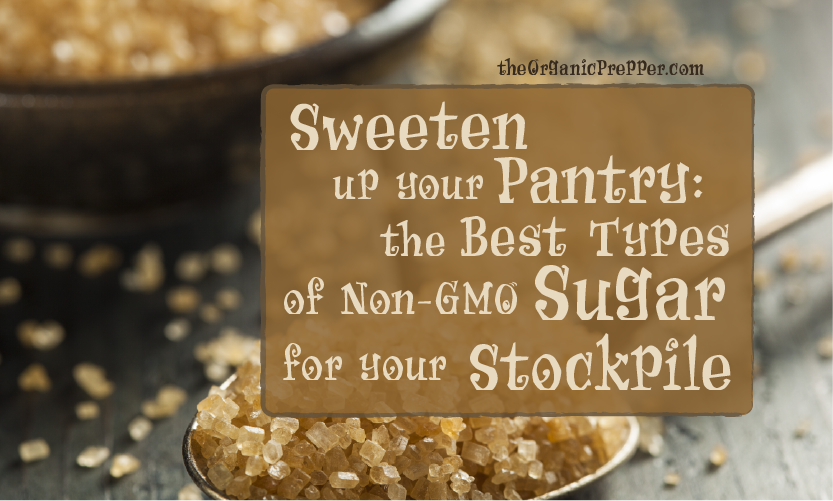If you're new here, you may want to subscribe to my RSS feed. Thanks for visiting!
By Daisy Luther
Having a healthy pantry doesn’t mean that you have to skip all things sweet and tasty. A spoonful of non-GMO sugar doesn’t just help the medicine go down. It can add a sense of normalcy and a little touch of luxury in a bad situation. Can you imagine celebrating a special occasion without dessert? Sugar can be used to activate the yeast in breadmaking, and in home preservation and jam-making.
It’s important to be particular about the source of your sugar, however. The white sugar that you get at most grocery stores is highly processed and any mineral content is lost in order to make the fine uniform crystals that we are all so familiar with. But it isn’t only nutritionally deficient. Table sugar comes from either sugar cane or sugar beets. An alarming 95% of the sugar beets grown in North America have been genetically modified to allow them to withstand the application of Monsanto’s pride and joy, Round-up pesticide. Sugar beets are beginning to keep pace with sugar cane as the source of sugar sold in North America. This means that you have a high chance of consuming GMOs whenever you eat something containing sugar unless that sugar has been carefully selected.
If you do buy white sugar, do your research and make sure it is made from 100% sugar cane. Although GMO sugar cane exists, it is not widely used.
[page_section template=’3′ position=’default’]
Do you want to prep but you’re not sure how to get started?

[thrive_link color=’teal’ link=’https://preppersuniversity.com/learn-about-the-prepping-intensive-courses/’ target=’_blank’ size=’big’ align=’aligncenter’]Which Prepping Intensive Course Is Right For Me?[/thrive_link]
[/page_section]
Look for organic or non-GMO sugar when building your sugar stock pile. It’s definitely more expensive but if you are going to include it in your diet, you want to be sure you aren’t consuming a Frankenfood.
Next, look at the type of processing that your sugar has undergone. You want to select a sugar that has been refined as little as possible. Some options (generally sourced from sugarcane) are:
Sucanat
This stands for SUgar CAne NATural. This is one of the least processed options available. The sugarcane juice is mechanically extracted and then heated and cooled to cause little brown crystals to form. (The brown color comes from the molasses content.) You can use sucanat in any way that you would use traditional brown sugar.
Turbinado Sugar
How much sugar do you need?
The three types of less processed sugars serve different culinary purposes, so all could have a place in the prepper’s pantry. An estimate for your sugar stockpile is 50 pounds per year, per person. Of course, this fluctuates based on your family’s diet so adjust accordingly.
Don’t forget other natural sweeteners. Not only do honey, maple syrup and molasses have distinct delicious flavors, they also contain vital minerals and have some natural medicinal values too.
- Blackstrap Molasses: Contains non-heme iron – can be used as a supplement for a person who is anemic. Always choose organic molasses – the heat processing it undergoes tends to concentrate the pesticides that were applied to the cane.
- Raw Honey: The list of medicinal uses for honey is nearly endless. It is a natural antibacterial, and because of this can be used topically for treating wounds or rashes. Honey is a great (and yummy) remedy for coughs and sore throats. To learn more about the benefits of raw honey, click here.
- Maple Syrup: This distinctively flavored sweetener is a great source of manganese and zinc, both of which help to boost the immune system.
An estimate for your sugar stockpile is 50 pounds per year, per person. Of course, this fluctuates based on your family’s diet so adjust accordingly.
That sounds like a lot, but remember, each time you bake yeast bread, you’ll add a bit of sugar to proof the yeast. If you are a coffee or tea drinker, you’ll add a few spoonfuls daily to your beverage. On special occasions that require a treat, you may use 1-3 cups of sugar at a time. It takes 9 pounds of sugar to make 5 gallons of wine. Hmmm….50 pounds per person might not be enough after all!
Shopping List
NOW Foods Sucanat(R) Organic Sugar Cane
Wholesome Sweeteners Organic Turbinado Raw Cane Sugar
India Tree Dark Muscovado Sugar
Plantation Blackstrap Molasses, Organic



















5 Responses
a good article on sugar thanks’. I need to ask though, why no mention of coconut sugar? This is almost the only sweetener that I will use!
Rick
Honestly, I’ve just never tried it, so it didn’t even cross my mind. 🙂 Why is this your number one choice? I’d love to learn more!
Daisy
I use it–if we are talking about coconut palm…have part of a 25 lb bucket in the pantry. It’s kinda halfway between turbinado and dark brown/muskovado. It’s grainy rather than like moist sand. Doesn’t taste like coconut and the taste is less “cloying” than a cane based. It is to the palm what maple sugar is to maple syrup. It also has a low index and your body processes it differently; supposedly it doesn’t spike blood sugar like regular sugar does but I”m not diabetic so I can’t answer to that (and I can’t get my diabetic, aspertame-adicted dad to touch it). Mother likes it in morning granola/yogurt/cereal mix. This is coming from a high-processed, “if they sell it it must be safe” household.
Cooking wise it’s okay but i’m not a talented baker so I can’t say how well it works in baked goods. Tastes like brown sugar in coffee.
Then there’s sorghum. I live in an area where this is grown for feed, but the molasses made from it is fantastic.
I don’t use sugar to proof my yeast. I use 1/4 cup of molasses for 2 loaves’ worth, and it makes fabulous tasting bread. I don’t use white sugar at all these days. I use molasses for bread, and everything else is Xyla or Stevia.